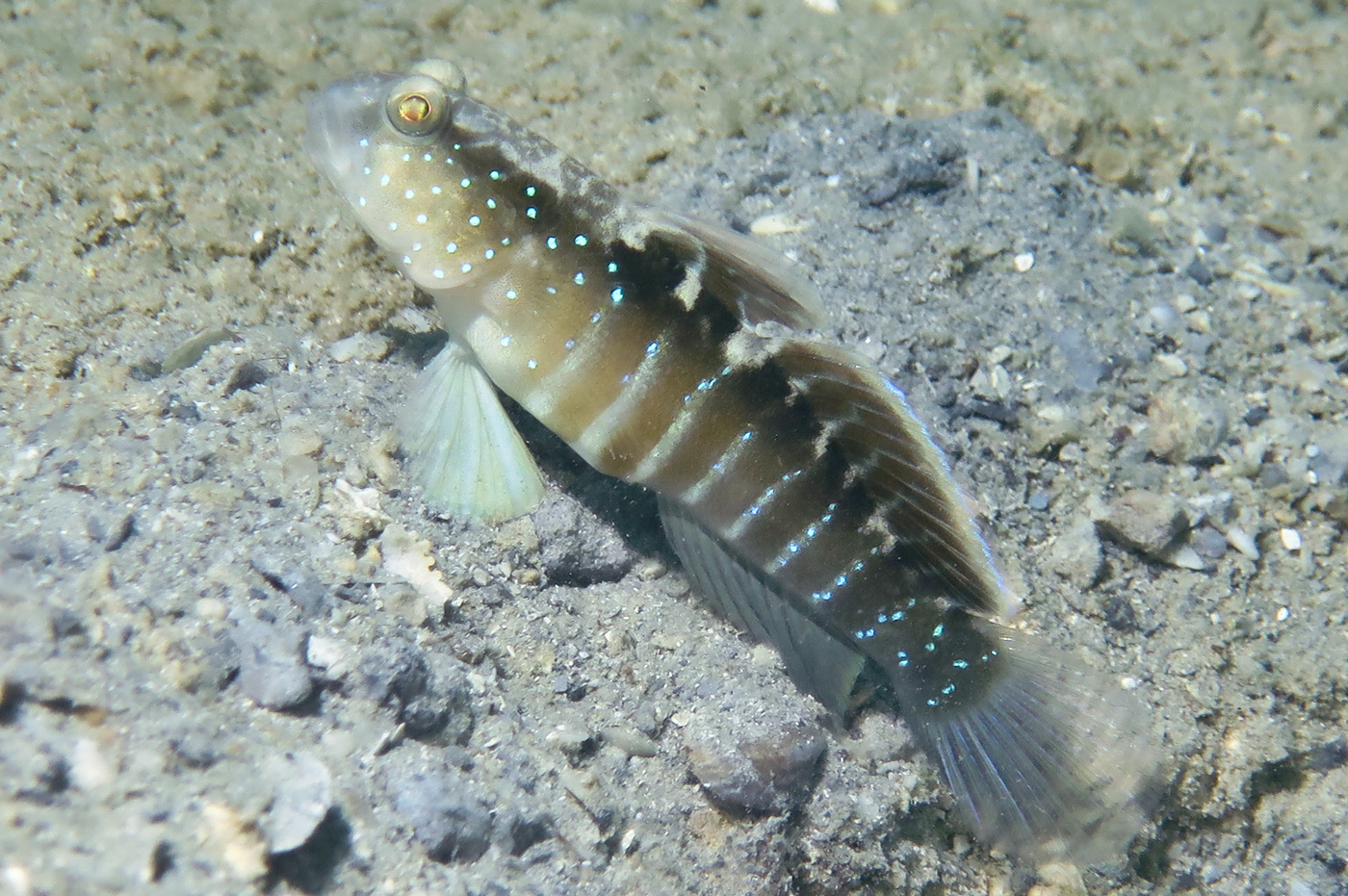- Classification
- ACTINOPTERYGII
- PERCIFORMES
- GOBIIDAE
- Cryptocentrus
- cyanospilotus
Bluespot Shrimpgoby, Cryptocentrus cyanospilotus Allen & Randall 2011

A male Shrimpgoby, Cryptocentrus cyanospilotus, on sand in sheltered waters in the Low Isles, near Port Douglas, Queensland, depth 8m. Source: Sue Churchill & Rogan Draper. License: All rights reserved
Summary:
Males are mostly brown with 7–8 narrow pale bars on the side extending onto the dorsal fin, and blue spotting on the head and rear of the body. Females are brown sometimes with several dark brown and pale grey saddles along the back, and small pale blue spots scattered on the head and body, spots more or less arranged in vertical rows on the body, and elliptical orange spots on the second dorsal fin.
Cite this page as:
Bray, D.J. 2016, Cryptocentrus cyanospilotus in Fishes of Australia, accessed 19 Apr 2024, https://fishesofaustralia.net.au/Home/species/5274
Bluespot Shrimpgoby, Cryptocentrus cyanospilotus Allen & Randall 2011
More Info
|
Distribution |
Low Isles, Queensland. Elsewhere the species occurs in the tropical west Pacific - Java Sea to Solomon Islands, Palau, and Yap, northward to Yaeyama Islands, Japan. Inhabits sheltered silty-sand areas. |
|
Features |
Dorsal fin VI-I,10; Anal fin I, 9; Pectoral fin usually 16; Scales in longitudinal series 49-54; Predorsal scales 10-13. Body depth at pelvic-fin origin 3.8-4.3 in SL; gill opening extending forward nearly to a vertical at posterior edge of preopercle. Scales ctenoid posteriorly on upper two-thirds of side anterior to level of about fifth or sixth soft dorsal-fin ray; scales cycloid on lower side, including abdomen, prepelvic region, and pectoralfin base; head naked except side of nape and predorsal region, scales extending anteriorly to level of rear margin of preopercle. Dorsal-fin spines progressively longer to fourth, longest 1.1-1.4 in HL; rounded caudal fin, longer than head, 2.7-3.2 in SL; pectoral fins reaching to level of second dorsal-fin origin, 3.4-4.0 in SL; pelvic fins reaching posteriorly to about anus, 3.7-4.1 in SL. |
|
Etymology |
The specific name cyanospilotus is from Latin and means 'blue-spotted', in reference to the diagnostic feature of the colour pattern. |
|
Species Citation |
Cryptocentrus cyanospilotus Allen & Randall 2011, Mar. Biol. Res. 7(6): 556, Figs. 1-5. Type locality: Ngargol Island, 7°05.897'N, 134°17.133'E, Palau Islands, depth 16 m. |
|
Author |
Bray, D.J. 2016 |
Bluespot Shrimpgoby, Cryptocentrus cyanospilotus Allen & Randall 2011
References
Allen, G.R. 2015. Descriptions of two new species of shrimpgobies (Gobiidae: Cryptocentrus and Tomiyamichthys) from Papua New Guinea. Journal of the Ocean Science Foundation 16: 67-81 PDF Open Access
Allen, G.R. & Erdmann, M.V. 2012. Reef fishes of the East Indies. Perth : Tropical Reef Research 3 vols, 1260 pp.
Allen, G.R. & Randall, J.E. 2011. Two new species of shrimp-associated gobies (Gobiidae: Cryptocentrus) from the Western Pacific. Marine Biology Research 7(6): 554-564. http://dx.doi.org/10.1080/17451000.2010.530545
Allen G, Steene R, Humann P, Deloach N. 2003. Reef Fish Identification Tropical Pacific. Jacksonville, FL: New World Publications. 457 pp. (as Cryptocentrus sp.)
Kuiter R.W. & Tonozuka, T. 2001. Indonesian Reef Fishes. Part 3. Jawfishes - Sunfishes, Opistognathidae - Molidae. Melbourne : Zoonetics pp. 623–893. (p. 632, as Cryptocentrus sp. 2)
Myers, R.F., 1999. Micronesian reef fishes: a comprehensive guide to the coral reef fishes of Micronesia, 3rd revised and expanded edition. Coral Graphics, Barrigada, Guam. 330 pp.



